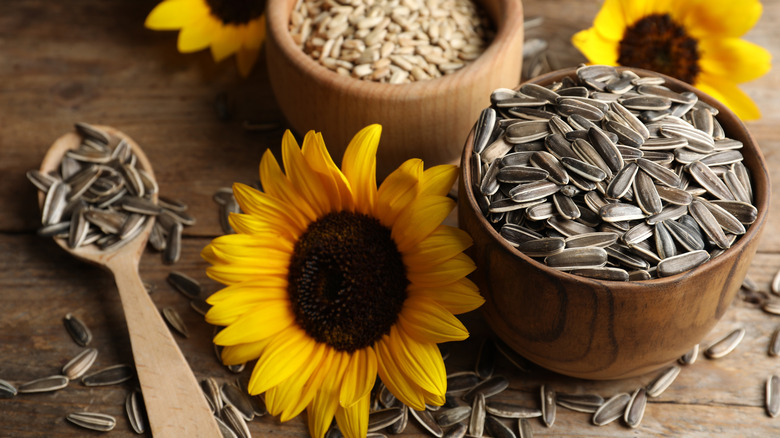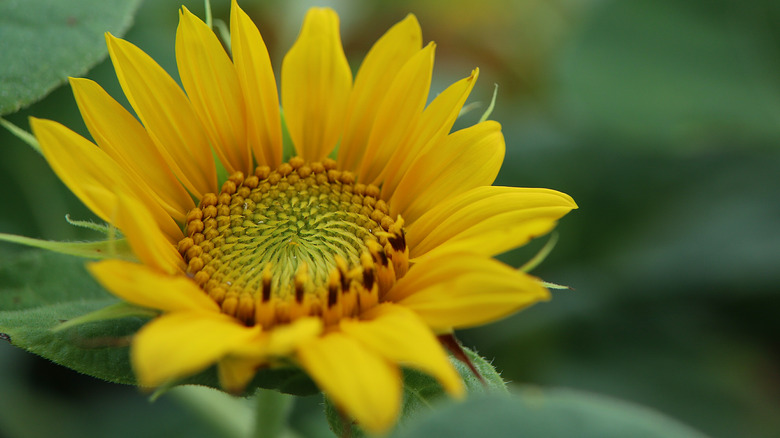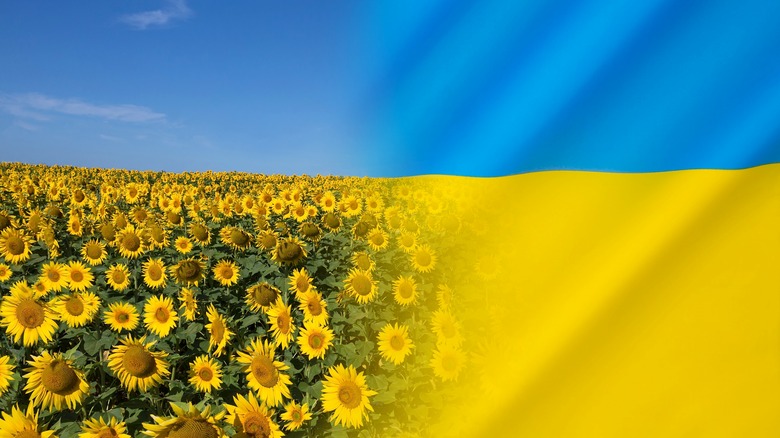Most Of The World's Sunflower Seeds Come From These 2 Countries
While sunflowers are often grown for their decorative value in home gardens, in Eastern Europe they are a major agricultural crop used for cooking oil, confectionary products, livestock feed, and as a healthy snack food for human consumption (per Agricultural Marketing Resource Center).
According to Statista, Ukraine and Russia combined produced 33 million metric tons of sunflower seed from September 2021 to August 2022, an output that accounts for over 50% of the entire world's sunflower production (per Earth Daily Agro). However, it may vary by year or reporting organization which of the two warring neighbors produces more sunflower oil and seeds. The Food and Agriculture Organization of the United Nations lists Russia as leading Ukraine by a small margin while Statista gives the edge to Ukraine.
The two nations' shared history explains why the colorful plants are such an important crop in the region.
Sunflower cultivation in Russia
Although Russia and Ukraine currently produce the majority of the world's commercially grown sunflowers, the plants are not actually native to Europe at all. According to The Orange County Register, sunflowers are native to the plains of North America and were first cultivated for flour and oil by Native American tribes in the region up to 4,500 years ago. When European explorers arrived in the Americas, sunflowers were one of the many crops they brought back to Europe, along with tomatoes, potatoes, corn, and pumpkins (per Britannica). However, The Orange Country Register notes sunflowers were mostly brought back for decorative and small-scale medicinal purposes.
Sunflowers didn't become a major agricultural staple until they were introduced to Russia. According to Russia Beyond, Czar Peter the Great — who was obsessed with all things fashionable in Western Europe — discovered sunflowers on a trip to Holland and thought they would look beautiful growing in Russian valleys. The plants did well in the region as the steppes of modern-day Russia and Ukraine have similar soil and climate conditions as much of the American Great Plains. After the Russian Orthodox Church issued a ban on butter, lard, and olive oil during Lent in the early 18th century, the market for sunflower oil boomed as an alternative. Russia became a major producer of sunflowers and began to hybridize the crop to improve efficiency, creating most of the modern, giant varieties the world knows today (via The Orange County Register).
Sunflowers as a Ukrainian symbol
When the war in Ukraine began in February 2022, many people became aware for the first time that the sunflower is the national flower of Ukraine, as it quickly became a popular symbol of the anti-war movement and support for the Ukrainian people in light of the Russian invasion (via Smithsonian Magazine).
Ukraine inherited its sunflower farming from Russia as the ethnically and linguistically unique region was largely controlled by the Russian Empire, starting in 1795, and later the Soviet Union, despite numerous attempts at earning independence (per History). After finally earning independence after the fall of the Soviet Union in 1991, Ukrainians embraced the now-ubiquitous sunflower as a national symbol. Not only does the plant occupy 6.5 million hectares of farmland in the country — 2 million more hectares than the entire EU dedicates to the crop (per CropRadar) — but they are regularly used as decorations and even in clothing and headdresses during regional celebrations, according to Smithsonian Magazine. They were first used as a symbol of peace in Ukraine in 1996 when the nation celebrated its nuclear disarmament with the help of the U.S. and Russia.
Ukraine is currently the number one exporting nation of sunflower oil in the world according to Tridge, with nations in Asia making up most of its customers. According to Statista, India and China purchased over $2.8 billion in sunflower oil from Ukraine in 2021. Sunflower oil can be used in a wide variety of cooking applications as it is seen as a fairly healthy oil option due to its low saturated fat content, a factor that has increasingly made it an attractive option for snack manufacturers (per Agiboo).
Impact of war
Whether using them to make healthy cooking oil or simply roasting the seeds as a low-fat, endlessly munchable snack – Russia Beyond reports sunflower seeds have been a guilty pleasure for Russians since the start of the Soviet era — there is no denying the importance of sunflower seeds to the world food market. Sadly, that market — along with the markets for wheat, corn, and other cereal grains – has been significantly uprooted by Russia's current war on Ukraine. In April, The Guardian reported the war had already caused a large jump in the prices of cooking oils across the board as manufacturers and countries sought to find replacements for Ukrainian-supplied imports after Russia cut off shipping routes in the Black Sea, with sunflower oil prices alone jumping by 60%.
Although inflation for Ukrainian- and Russian-supplied foods, including sunflower oil and wheat, had slowed down after a trade agreement was reached in July between the two nations to allow for agricultural exports, prices could jump again in November, adding to already record global food inflation, since Russia announced it would not be renewing the deal on October 29 (per Reuters). Reuters reports that already the move has triggered a 6% uptick in wheat futures and it is likely other products, including sunflower, will follow suit.



